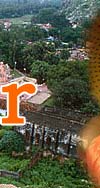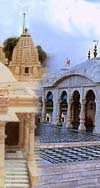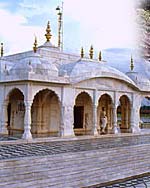 |
Encyclopedia of Tours and Travel to Bihar, featuring information on Fairs & Festivals, Wildlife, Excursion, Adventure and Weather of Bihar. |
 |
 |
 |
 |
 |
 |
 |
||
|
Bihar

Bihar's antiquity is evident from its name, which is derived from
"VIHARA" (monastery). It is indeed a land of monasteries.
Hindu, Buddhist, Jain, Muslim and Sikh shrines abound in this ancient
land where India's first major empires rose and fell. Where the
ruins of the worlds' earliest university slumbers in the void of
time, while modern day giant steel complexes spew fire all the year
round. Forty percent of India's mineral wealth lies buried in its
boosom. The passage of Ganga, flowing wide and deep enrich the plains
of Bihar before distributing in Bengal's deltoid zone. The Khuda Baksh Oriental Library has rare Muslim manuscripts including some from the University of Cordoba in Spain. 40 km away, Vaishali, was the site for the second Buddhist Council is the presence of ruins testify. 90 km south of Patna is Nalanda which translates as the place that confers the lotus’ (of spiritual knowledge). A monastic university flourished here from the 5th to the 11th century. It is said to have contained nine million books, with 2,000 teachers to impart knowledge to 10,000 students who came from all over the Buddhist world. Lord Buddha himself taught here and Hieun Tsang, the 7th century Chinese traveler, was a student. Ongoing excavations have uncovered temples, monasteries and lecture halls. Rajgir, ‘the royal palace’, 12 km south, was the venue for the first Buddhist Council.
The Buddha spent five years at Rajgir after having attained enlightenment, and many of the remains at Rajgir commemorate various incidents, the hill of Gridhrakuta being perhaps the most important, as this is where the Buddha delivered most of his sermons. Bodhgaya is the spot where Lord Buddha attained enlightenment, with the Mahabodhi Temple marking the precise location. Bihar’s Buddhist circuit has modest back-up facilities by way of accommodation, international dining and surface transport. Magadh rose to glory again during the Guptas(4th and 5th centuries AD) followed by the Palas of Bangal, who ruled until 1197. Muslim rule, which lasted from the 12th to 17th century, has left an indelible mark on Bihar. The British acquired Bihar in 1764 in the Battle of Buxar and ruled until India's Independence 1947. In its early history, from the 6th century BC to 5th century AD, the region was repeatedly the coveted seat of major empires. Ajatshatru, second in the line of the Magadh kings, ruled from Rajgir. The 4th century BC saw the rise of the Maurya dynasty to which Ashoka belonged. This landlocked state is surrounded by Nepal, Bengal, Orissa, Madhya Pradesh, Uttar Pradesh and comprises four cultural regions-Bhojpur, Mithila, Magadha and Chotanagpur. Rivers Kosi and Gandak from the north and Sone from the south join the Ganga. River Damodar flows through the picturesque Chotanagpur plateau and its valley is the Rohr of India. In the fertile plains, rice, sugarcane, oilseeds, gram, maize, jute, barley and wheat are cultivated. Under the soil, Bihar has either ruins or minerals.
|
|||||||||||||||||||||||||||||||||||||||||||||||||||||||||
|
|||||||||||||||||||||||||||||||||||||||||||||||||||||||||
|
|||||||||||||||||||||||||||||||||||||||||||||||||||||||||